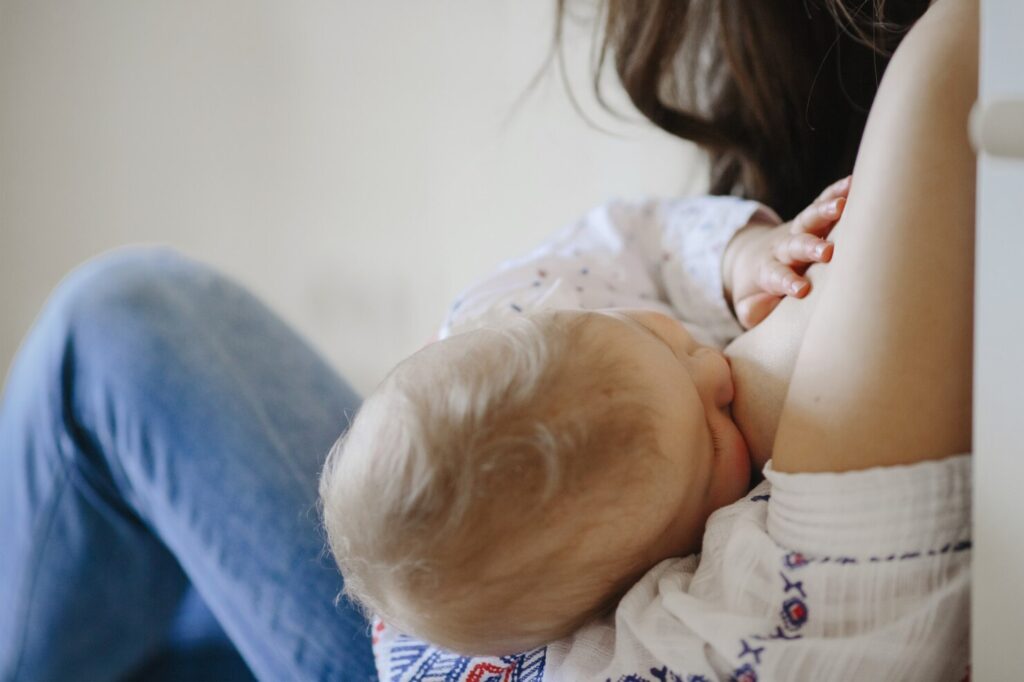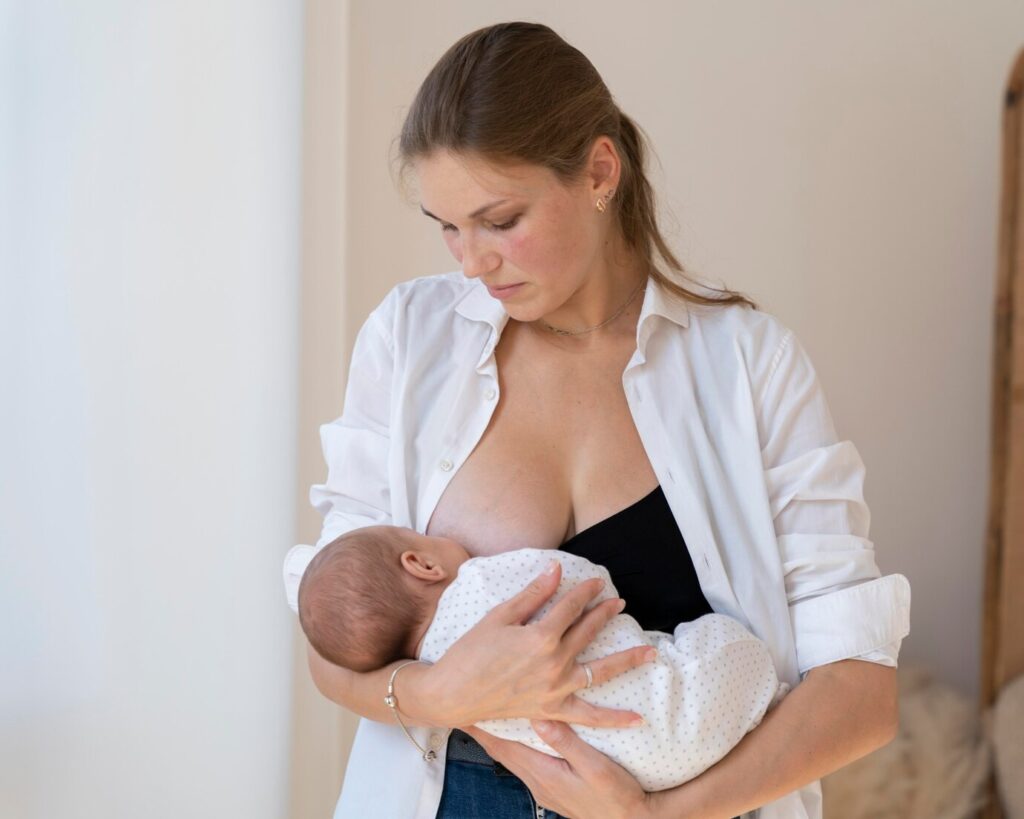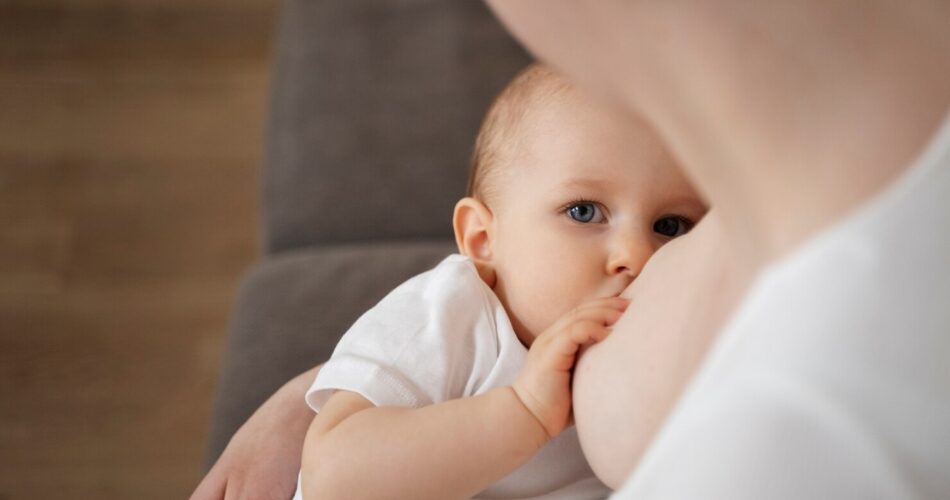Almost all women who have just become mothers face the issue of pain during breastfeeding. It can be caused by various reasons, which must be identified and promptly addressed. In addition to the discomfort that breast pain causes the nursing mother during feeding, this situation can also negatively affect the baby’s well-being, preventing them from gaining weight properly.
Additionally, breast pain during breastfeeding can also occur because inflammatory processes are starting in the mammary glands, which require immediate treatment. To make breastfeeding a pleasant interaction between mother and her baby, it is necessary to eliminate the conditions that cause painful sensations during feeding.

Causes of Pain While Breastfeeding
There can be several causes of pain during breastfeeding. Some of these are natural, indicating the processes occurring in a woman’s body at the beginning of lactation. The birth of a child causes the production of milk by the mammary glands due to oxytocin and prolactin. The sudden influx creates unpleasant sensations in the breast – swelling, tingling, or pressure. It may take several months to regulate the lactation process.
At this time, pain caused by engorgement is considered normal. It can be alleviated by breastfeeding the baby more frequently. Additionally, temporary discomfort and pain during breastfeeding may occur due to a very simple reason – wearing inappropriate clothing, which is why tight bras are not recommended during the breastfeeding period.

Pathological Causes of Breast Pain While Breastfeeding
There are also a number of reasons that cannot be considered natural when breast pain occurs during breastfeeding, and they require measures to be taken for resolution. These include:
- Nipple cracks – the delicate skin of the nipples and breast, not yet adjusted to the sucking process, as well as improper latching technique during feeding, can lead to small cracks appearing on the nipples. In this case, the breast hurts most intensely during feeding and gradually subsides after it is over.
- Lactostasis – due to an excessive amount of milk, its increased density, and insufficient patency of milk ducts, there is a stagnation in the milk lobules, leading to painful lumps. Expressing milk is mandatory to eliminate them and prevent the development of mastitis.
Breast Pain – Thrush and Mastitis
More dangerous reasons for breast pain during feeding can also include mastitis, which occurs due to pathogenic microbes entering the milk lobule through nipple cracks or inflammation during lactostasis, leading to a serous, and later, purulent process. There is severe throbbing pain, body temperature rises, the skin burns and becomes red. In this case, the nursing mother requires urgent medical care, as neglected forms can quickly lead to the development of a breast abscess.
Another serious cause of breast pain can be thrush, which occurs with oral thrush candidiasis in infants. Fungal colonies from the mother’s nipple skin can penetrate the milk ducts, leading to thrush. The main clinical symptoms are itching in the breast, increased nipple sensitivity, stabbing or cutting pain occurring after breastfeeding.

Should you breastfeed with sore nipples?
Nursing women who experience breast pain while feeding their baby naturally question what to do—whether to stop breastfeeding until the causes are resolved or to continue despite the discomfort and pain. Experts believe that unless otherwise advised by a doctor, it is necessary to adhere to the standard procedure despite the pain during breastfeeding. Stopping or taking breaks in breastfeeding may lead to a decrease in milk production.
Until the nipples become less painful and to prevent further irritation, you can use a breast pump. Even if a woman is diagnosed with mastitis, breastfeeding is recommended to continue. In addition, breast and nipple pain with mastitis can even increase when pumping or breastfeeding is stopped. Unless advised otherwise by a doctor, breastfeeding should also continue with thrush, even if the breasts hurt during feeding.
How to feed properly to reduce nipple pain?
Once you understand why the breasts are sore and take appropriate measures to address the cause, it’s important to focus on reducing breastfeeding pain that occurs in the nipples. This can only be achieved by identifying the cause during an in-person consultation with a lactation specialist, monitoring the process, and assessing its correctness.
If your nipples hurt, relief is needed:
- ensure the baby latches onto the nipple correctly by placing it deeply in the mouth; try different feeding positions;
- allow the baby to release the nipple on their own before removing them from the breast;
- do not use gel or soap for nipple hygiene; use special pads in the bra;
- undergo a treatment course for infections using antibiotics or antifungal medications.
Consultation with a doctor is essential if nipple pain persists for more than a day, the pain increases, or there is a fever.
Pain while feeding: tensions and clamps in the baby
Breastfeeding can become painful due to muscle tension and constrictions in the baby, which lead to involuntary squeezing of the nipple by the baby’s gums. As the child grows older, these actions can be deliberate, as they try to differentiate their “self” from their mother. In the first case, it is important to avoid situations that may trigger such reactions from the baby.
Mothers should try to create a calm, comfortable atmosphere during feeding to prevent nervousness. Do not force the baby to latch onto the breast or take it away forcefully. At a more conscious age, especially during teething, when the baby tries to press the nipple with their gums, you should remove the breast and clearly express your displeasure.
Treatment of Cracks
If the reason for breast pain during breastfeeding is the formation of small cracks on its delicate skin and nipples, which bothers the mother, measures need to be taken for their treatment. Often, women try to deal with the problem using home remedies. For example, after breastfeeding, they leave a small amount of breast milk on the area. However, in some cases, the effectiveness of this approach is low, and other methods of elimination are required.
You can apply castor oil, sea buckthorn oil, or rosehip oil to soften the skin and heal the cracks quickly by applying it after feeding. Purified lanolin is also helpful, and gel compresses should be used. To speed up the healing of nipple skin, you can use ointment based on pro-vitamin B5 – for instance, ‘Bepanthen’. In addition to the mentioned ingredient, this remedy for treating cracks includes highly concentrated lanolin.



Download the app and get 7 days free use
 eng
eng rus
rus deu
deu spa
spa fra
fra ita
ita por
por srp
srp tur
tur ukr
ukr por
por bos
bos



